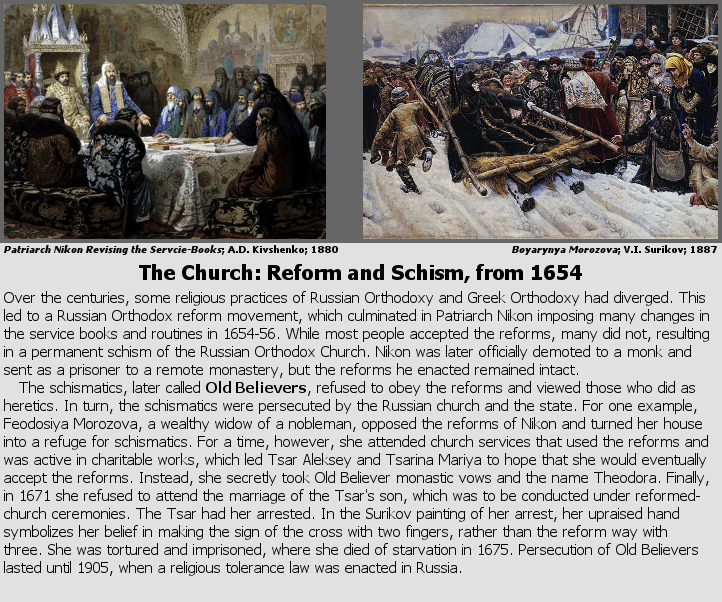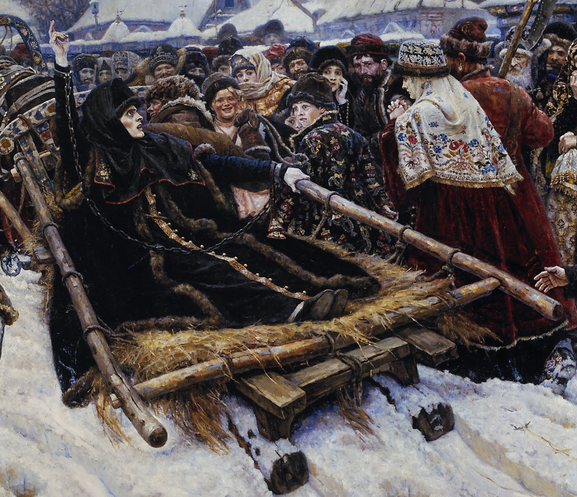

The Church: Reform and Schism, from 1654
Over the centuries, some religious practices of Russian Orthodoxy and Greek Orthodoxy had diverged. This led to a Russian Orthodox reform movement, which culminated in Patriarch Nikon imposing many changes in the service books and routines in 1654-56. While most people accepted the reforms, many did not, resulting in a permanent schism of the Russian Orthodox Church. Nikon was later officially demoted to a monk and sent as a prisoner to a remote monastery, but the reforms he enacted remained intact.
The schismatics, later called Old Believers, refused to obey the reforms and viewed those who did as heretics. In turn, the schismatics were persecuted by the Russian church and the state. For one example, Feodosiya Morozova, a wealthy widow of a nobleman, opposed the reforms of Nikon and turned her house into a refuge for schismatics. For a time, however, she attended church services that used the reforms and was active in charitable works, which led Tsar Aleksey and Tsarina Mariya to hope that she would eventually accept the reforms. Instead, she secretly took Old Believer monastic vows and the name Theodora. Finally, in 1671 she refused to attend the marriage of the Tsar's son, which was to be conducted under reformed-church ceremonies. The Tsar had her arrested. In the Surikov painting of her arrest, her upraised hand symbolizes her belief in making the sign of the cross with two fingers, rather than the reform way with three. She was tortured and imprisoned, where she died of starvation in 1675. Persecution of Old Believers lasted until 1905, when a religious tolerance law was enacted in Russia.
Comments

Detail from Surikov's Boyarynya Morozova, showing the noblewoman holding up two fingers in Old Believer style as she is dragged off to prison in chains
The Russian Orthodox Church was an independent church, but the Greek Orthodox Church was regarded as the original orthodox church. When it became evident that some of the practices of the Russian church were different than those of the Greek church, this gave rise to a movement to change the Russian practices. This was realized in the reforms of Patriarch Nikon, which also caused a schism in the church when the Old Believers refused to accept the reforms.
The practices of the Greek and Russian churches actually had both evolved over time. Much later, scholarship established that the Russian church had often followed the original ones. Had this been realized at the time, the reforms and schism might not have occurred, avoiding all the suffering and sometimes death the schism entailed.
In these days, there are many people who do not believe in organized religions or even in religion at all, although there are also many believers. Even among believers today, many are tolerant of religions and practices that are not their own. In the past, this was not the case. The vast majority of people believed in their religion, as moral guidance for this world and for their prospects in the afterlife. Sin and heresy thus were seen as vary dangerous to people's wellbeing. This made things that many today see as trivial, like whether Russian Orthodox Christians should make the sign of the cross with three fingers (per the reforms) or two fingers (per Old Believers), extremely important.
The actual causes of most natural catastrophes in the world were only discovered in the 19th and 20th Centuries. Before then, when ruinous weather, famines, plagues, earthquakes, volcanic eruptions, and so on occurred, people often attributed them to divine power punishing the sinful and wicked. Sometimes, this was seen as punishment for the people being wicked. At other times, the people saw it as punishment for the country having false or ungodly leaders. To many, the famine in Russia that started in 1601, where cold weather and flooding ruined crops, was a sign of divine displeasure with Russia's leaders. It is likely many starving people believed that Russia was being punished for Tsar Boris Godunov, who seized the throne and allegedly had Dmitriy, son of Tsar Ivan IV, killed. This explains the appeal of the false Dmitriys, as people rallied to them hoping to restore what they thought was the rightful tsar of Russia. Similarly, it is likely many believed the Church leadership had become wicked, leading to the belief that church officials and the monasteries were hording grain, planning to sell it at high prices during the famine. This likely contributed to the collapse of moral social order in the countryside, making things worse.
Belief in one's religion went all the way to the top of the country: the tsars and tsarinas. They wanted their Orthodox Christian subjects to be pious, for the good of the country. At times, their beliefs led them to persecute adherents of other religions. Ivan IV was intolerant of Muslims and tried to forcibly convert the Muslims of Kazan to Christianity after his army conquered that city. Since people of other religions believed their ways were right, they were highly resistant to conversion, and Russia to varying degrees came to tolerate its long-time Muslim subjects in return for their loyalty. Old Believers remained another matter, since to tsar and church they were heretics trying to subvert good Christians to their sinful ways. Old Believers were often persecuted for their beliefs by both church and state.
Even ignoring the horrifying ways of Ivan IV, many tsars were excessively brutal, using torture and execution to maintain their power, sometimes with little effort to determine if the accused were actuall guilty. They also started deadly wars with other countries often for no reason other than conquest. Their personal lives, when compared to what the Russian Orthodox Church taught, were often immoral and sinful. Nonetheless, the tsars believed themselves to be pious and their actions justified by the belief that they were divinely chosen and were enforcing God's will.
The Russian church and Russian monarchy supported and reinforced one another. The tsar had considerable power over the church but not full control. The patriarchs of the church had considerable power and could in theory oppose the will of the tsars. The patriarchy was self-perpetuating, as on the death or demotion of a patriarch, the Russian bishops would elect a new one. Pyotr the Great changed this, by abolishing the patriarchy and establishing a synod under the tsars' control to administer the church. This situation lasted until 1917, when Tsar Nikolay II abdicated and the patriarchy was reestablished.